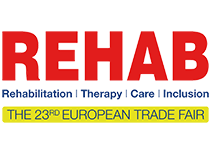Products and services at the Marketplace Cerebral & Neurological Rehabilitation
Among others, the Marketplace Cerebral and Neurological Rehabilitation informs about the following topics:
Much patience is needed after a brain injury
In case of a brain injury, it is the acute care of the first moment that counts the most. After that, it is mostly patience which is needed until the brain - supported by individualised therapies and aids - can gradually recover.
Brain injuries can a variety of causes, the most frequent being craniocerebral injuries, a stroke or a cerebral haemorrhage. Furthermore, brain tumours, inflammatory illnesses or an oxygen deficiency, triggered by an accident or cardiac arrest, may lead to damages to the brain. The consequences vary per individual and depend on the affected area of the brain and the severity of the injury.
Immediately after the acute care, neurological rehabilitation should begin. The impaired or lost functions will determine which treatments may be necessary in case of a brain injury. In addition to physical disabilities, such as failures in vision, paralyses or dysphagia, cognitive problems may occur as well, for example if memory or attention and problem-solving capabilities have been affected.
It takes a lot of time until the brain can form new connections and synapses. Specific training can support the regeneration of disabled people with brain injuries. Together with carers, speech therapists, physical therapists, occupational therapists and psychologists, people affected by a brain injury take many small steps towards more self-reliance.
REHAB offers visitors the opportunity to gain an overview of therapies, aids, services and support offers for brain injuries.
A return to normal life with neurological rehabilitation
After a stroke or an illness of the central nervous system, neurological rehabilitation helps to recover lost capabilities, with the goal of returning to a largely self-sufficient life.
Neurological rehabilitation encompasses the medical treatment of people with a damaged nervous system. An accident, an infectious or vascular disease of the brain or chronic neurological illnesses, such as Multiple Sclerosis, may cause disruptions to the nervous system, all the way to massive damages to brain, spinal cord and peripheral nerves. Symptoms vary by individual and are diverse, ranging from impaired vision to the loss of speech ability or loss of consciousness. Specific therapy measures generally start right after the acute clinical care - as follow-up treatment of patients with neurological illnesses.
The neurological rehabilitation of disabled people aims to reduce functional impairments, restore lost capabilities and thereby pave the medical way back to a normal life. The earlier therapies begin to promote perception, motion and communication, the better the chances of success.
The neurological rehabilitation is divided into stages, ranging from A (primary care) to E (follow-up care and professional rehabilitation) or F (activating long-term care with continuously high need for care). Exhibitors at REHAB will present a broad spectrum of services and products for each neurological rehabilitation stage. The Marketplace Cerebral Rehabilitation invites persons affected as well as relatives, doctors, carers and therapists to engage in an active exchange.
Conquering a stroke and its consequences together
Only together can the impact of a stroke be overcome - in close cooperation between doctors, therapists, relatives and the affected person as well as help from supporting offers.
During a stroke, the brain is not sufficiently supplied with blood and subsequently, nerve tissue is damaged, most frequently as consequences of a vascular obliteration or cerebral haemorrhage. While acute care primarily aims to remove the cause of the stroke, therapies for the subsequent damage must be individually tailor-made for the person impaired by the stroke.
The treatment in case of a stroke depends on the corresponding functional dysfunctions and may include physical therapy, speech therapy, sports therapy, occupational therapy, psychological treatment and even animal-focused therapies. Many people who have been impaired by a stroke can learn to speak and walk again and manage their daily life independently. Others will remain temporarily or permanently in need of care but can profit from activating long-term care which animates the patients to collaborate following a structured concept (such as Bobath concept).
At the same time, practical support must be ensured for patients and relatives, for example through the use of outpatient care services and technical aids, restructuring measures for a barrier-free environment, trainings for caretaking relatives or visiting self-help groups. REHAB offers visitors the opportunity to gather extensive information about the newest developments in rehabilitation options after a stroke.

